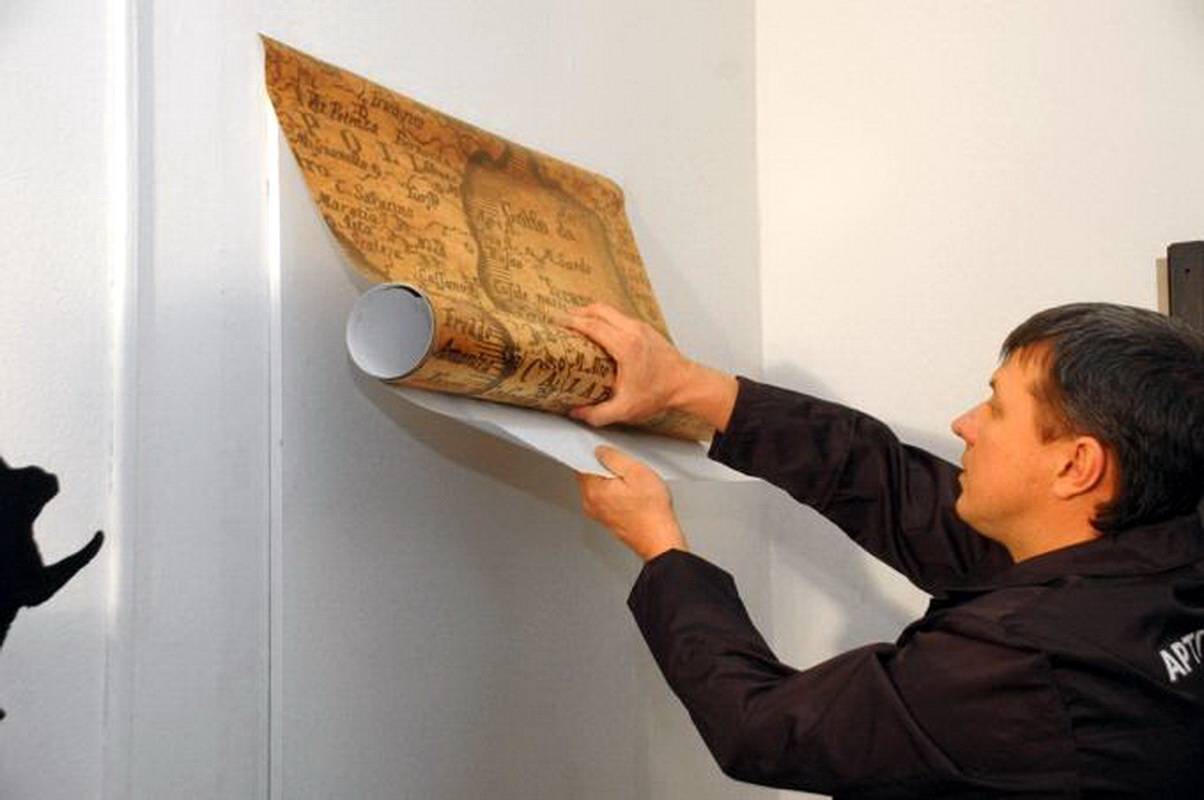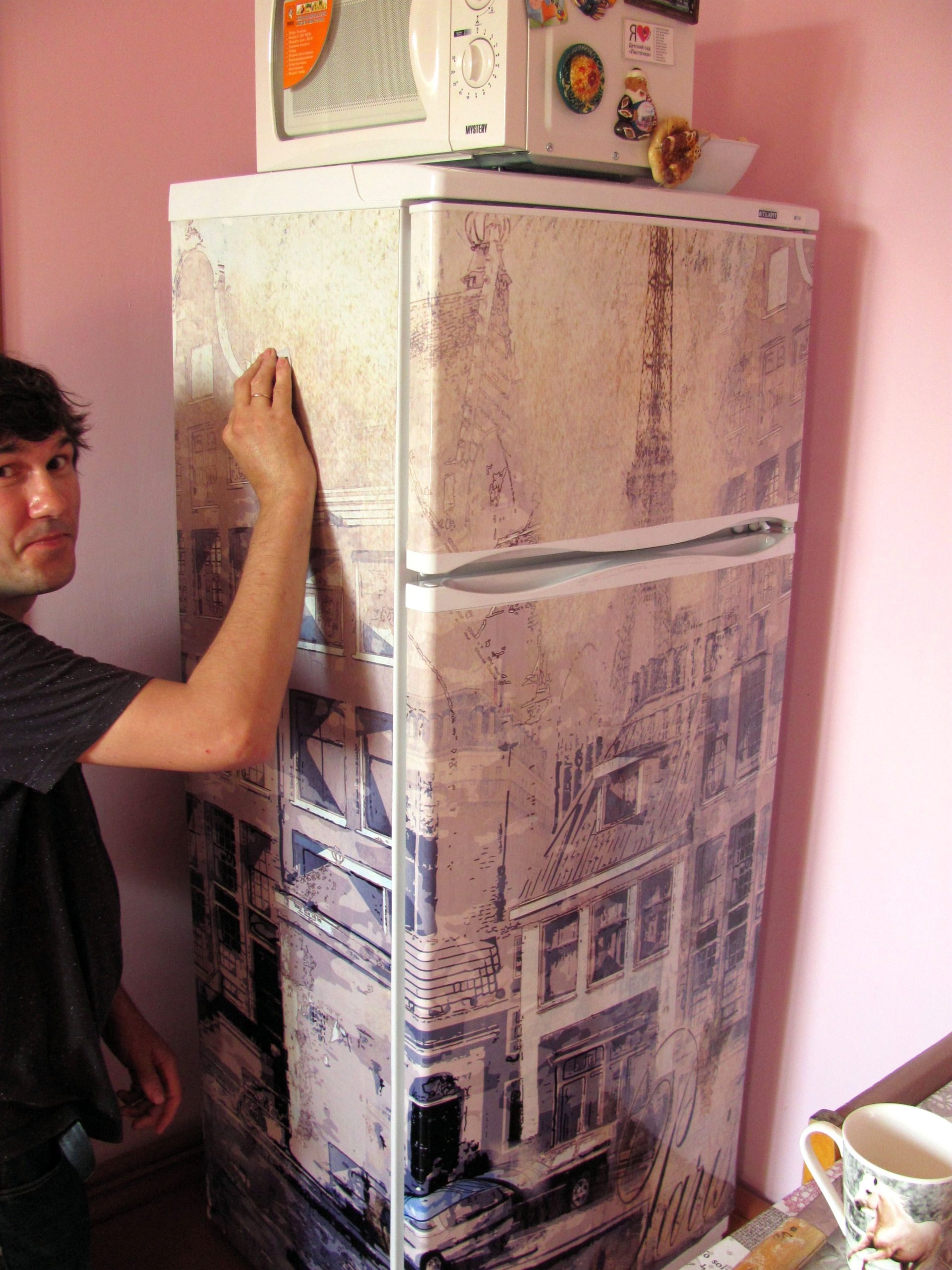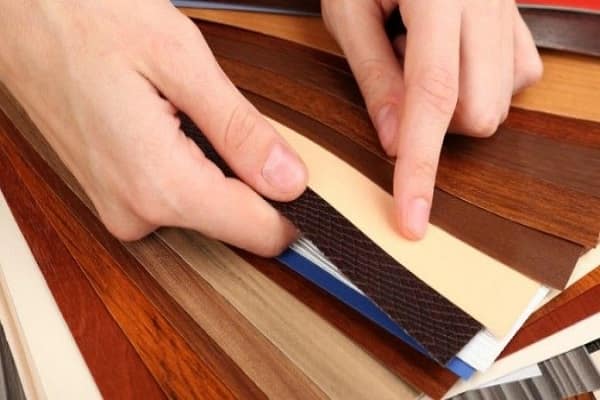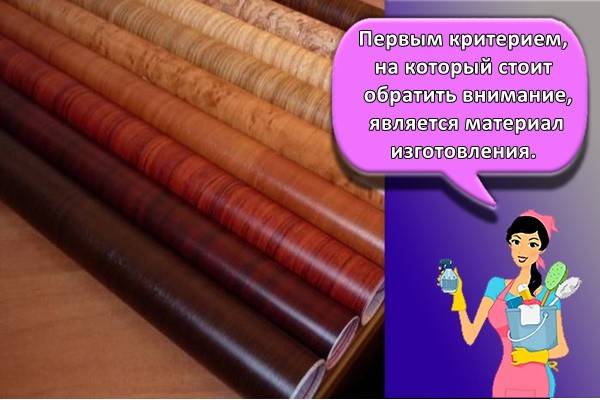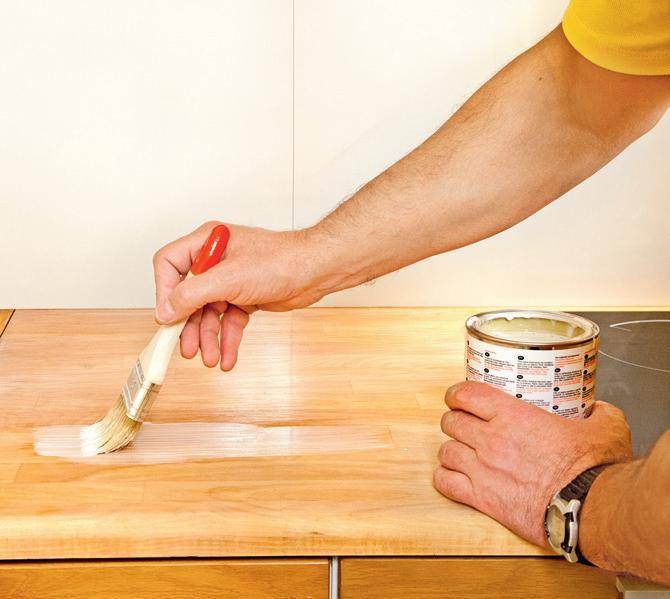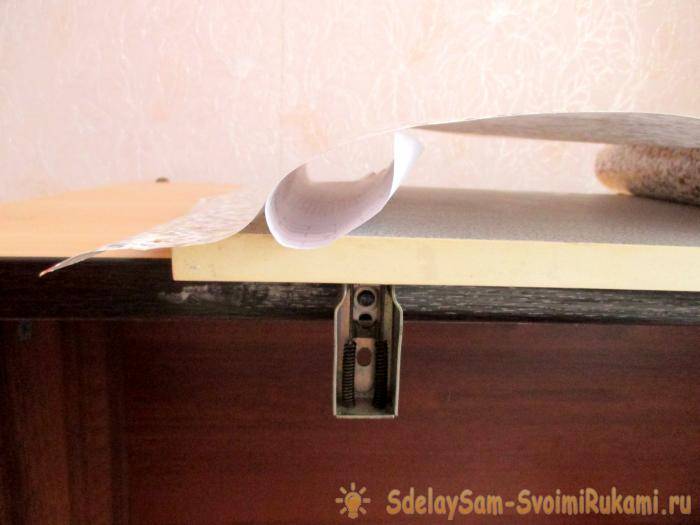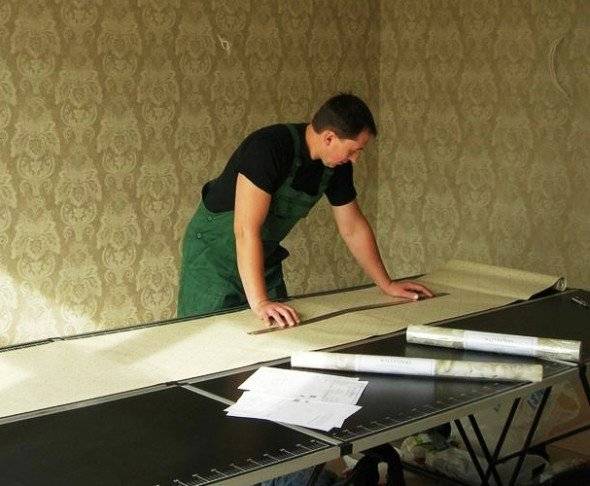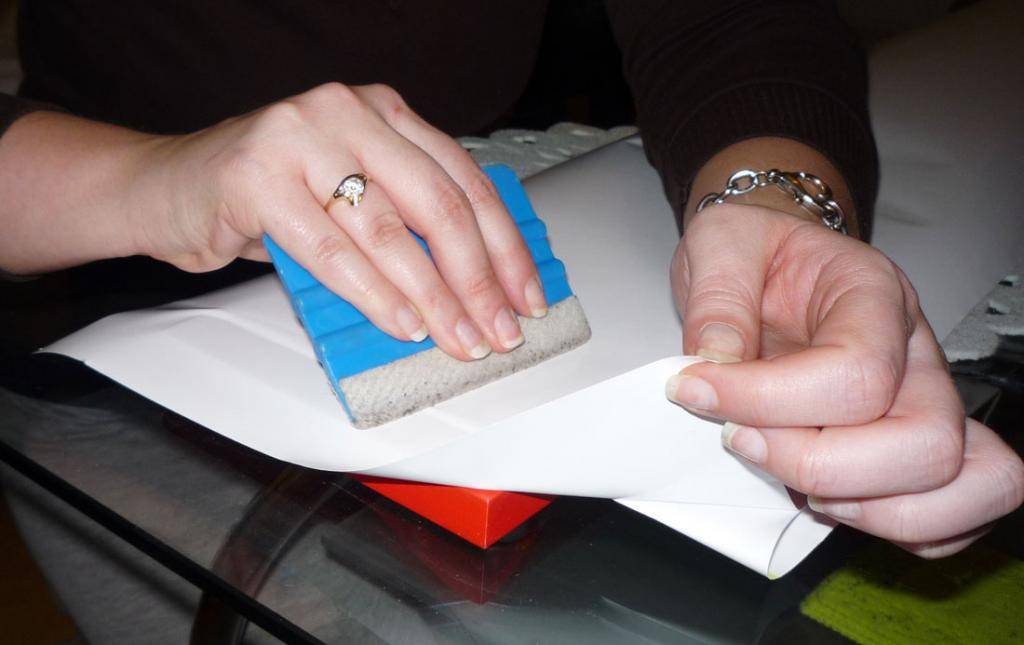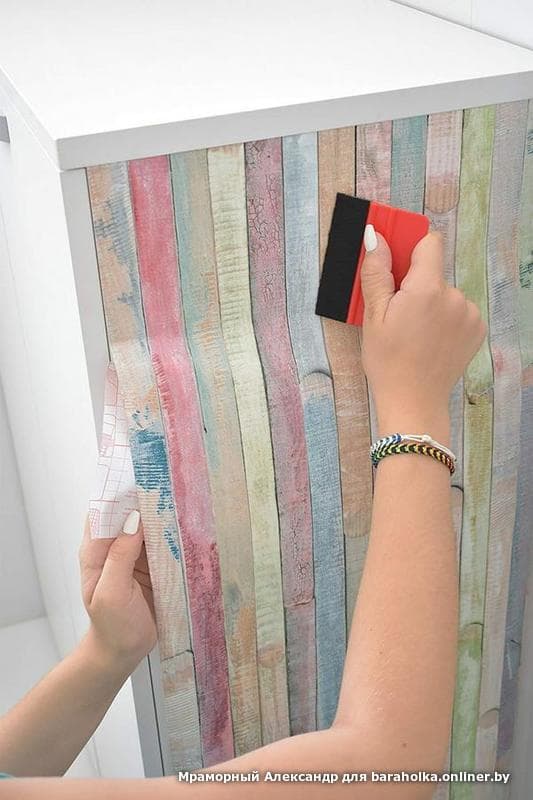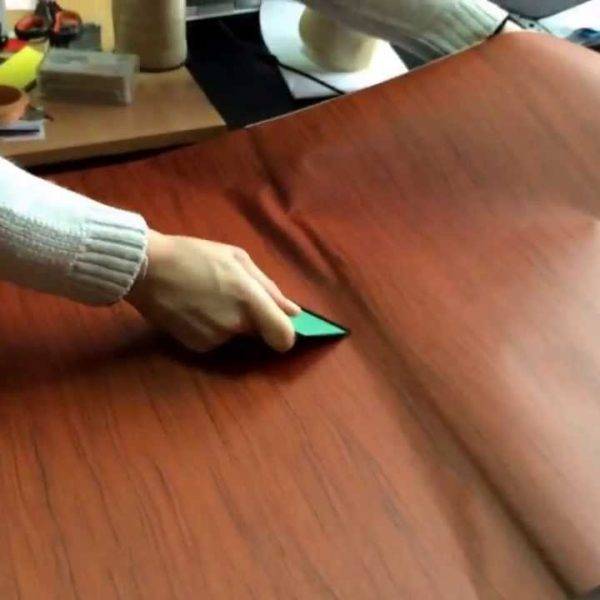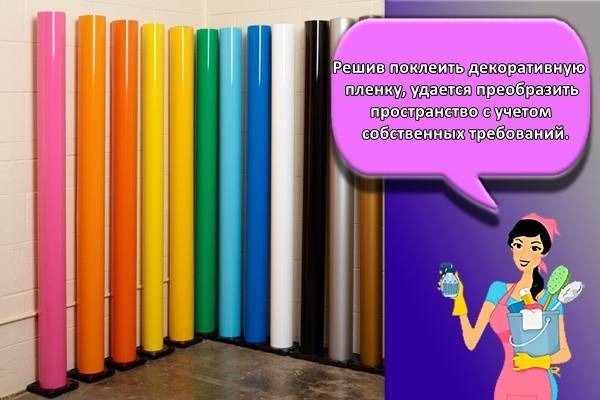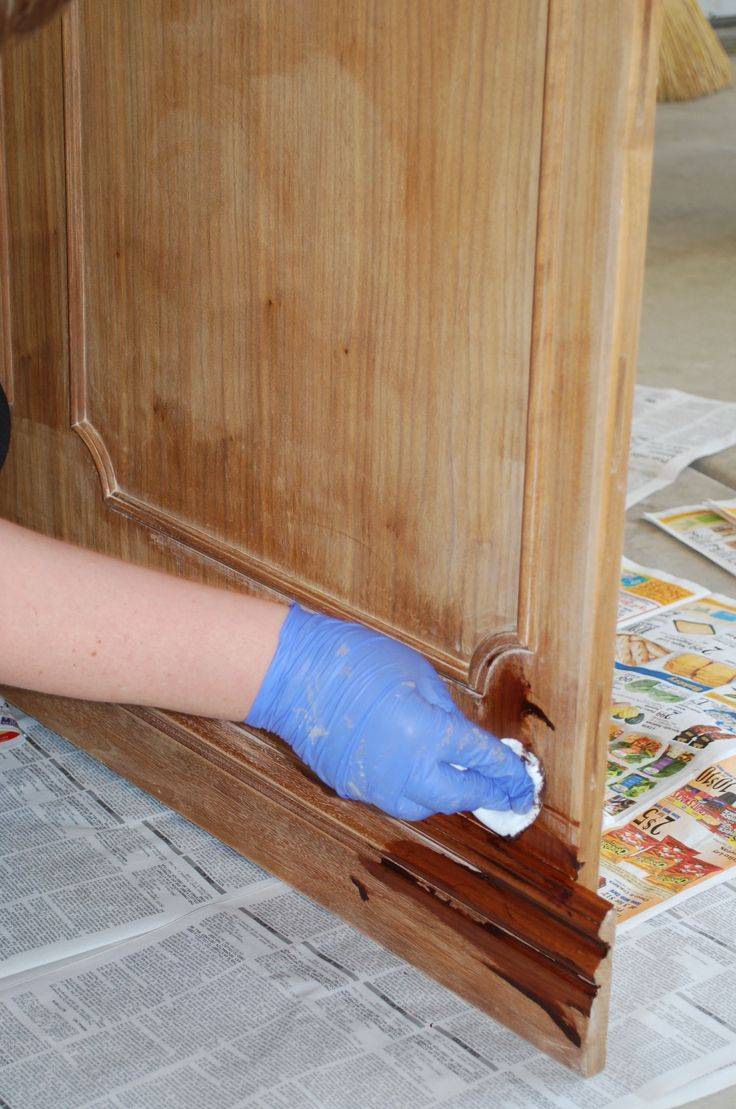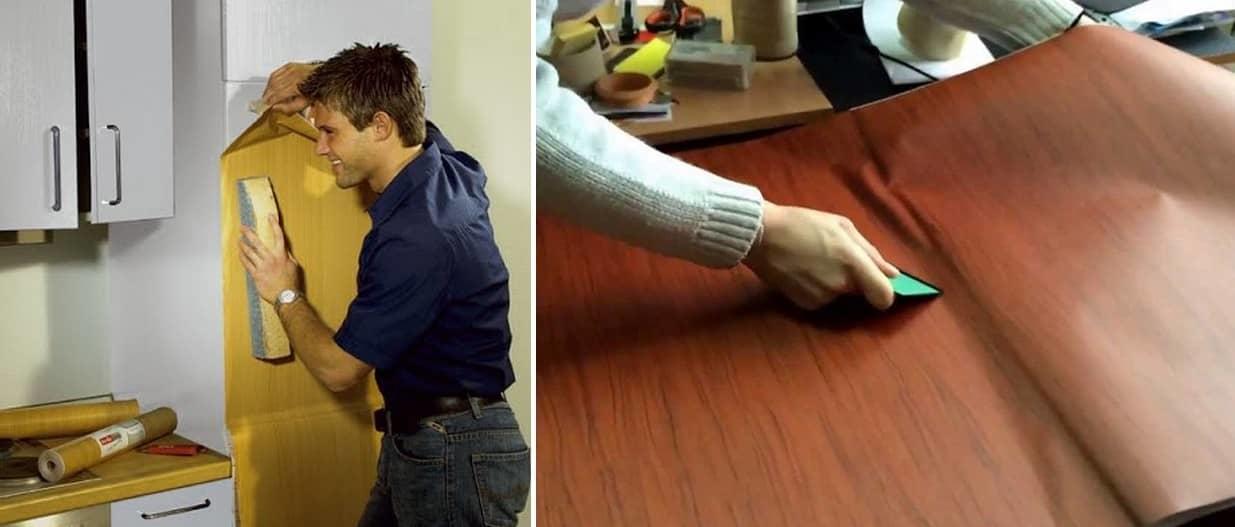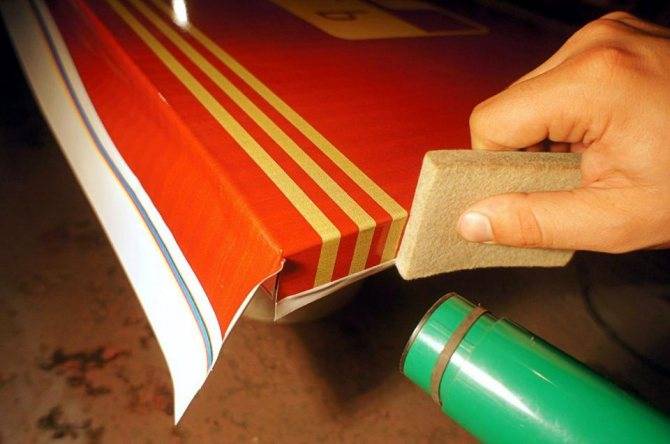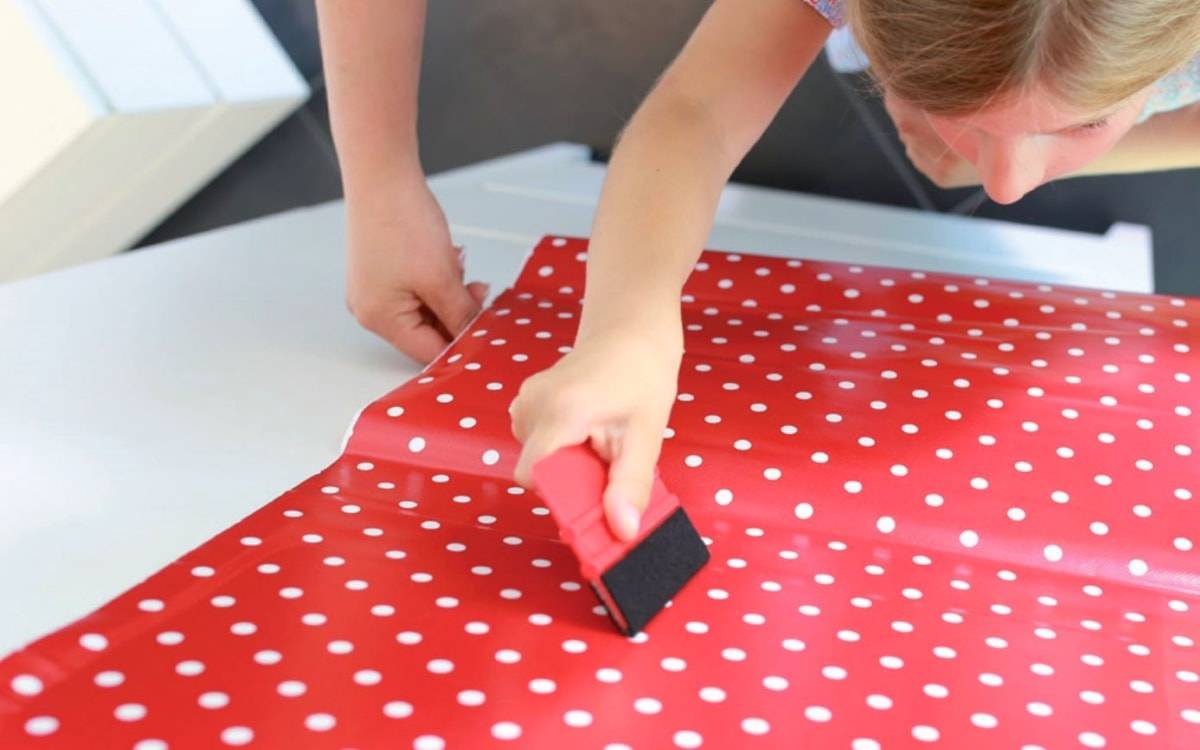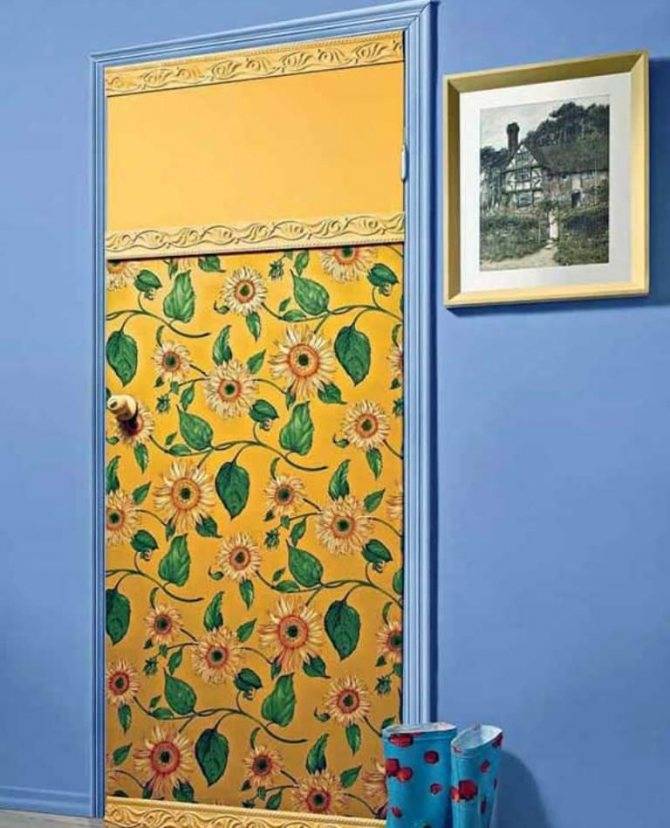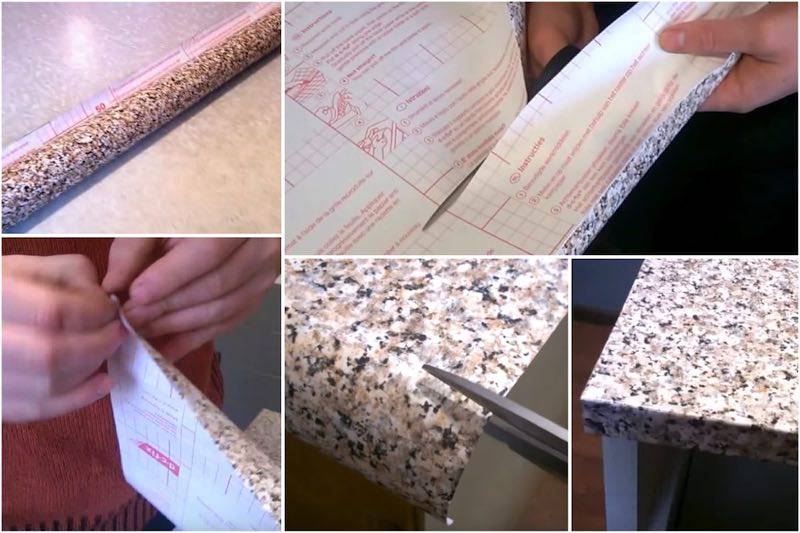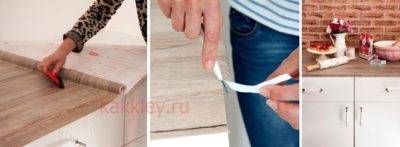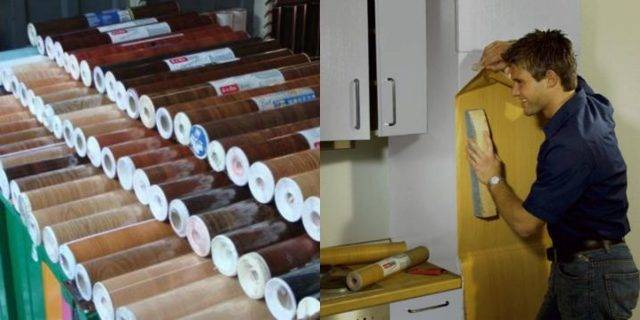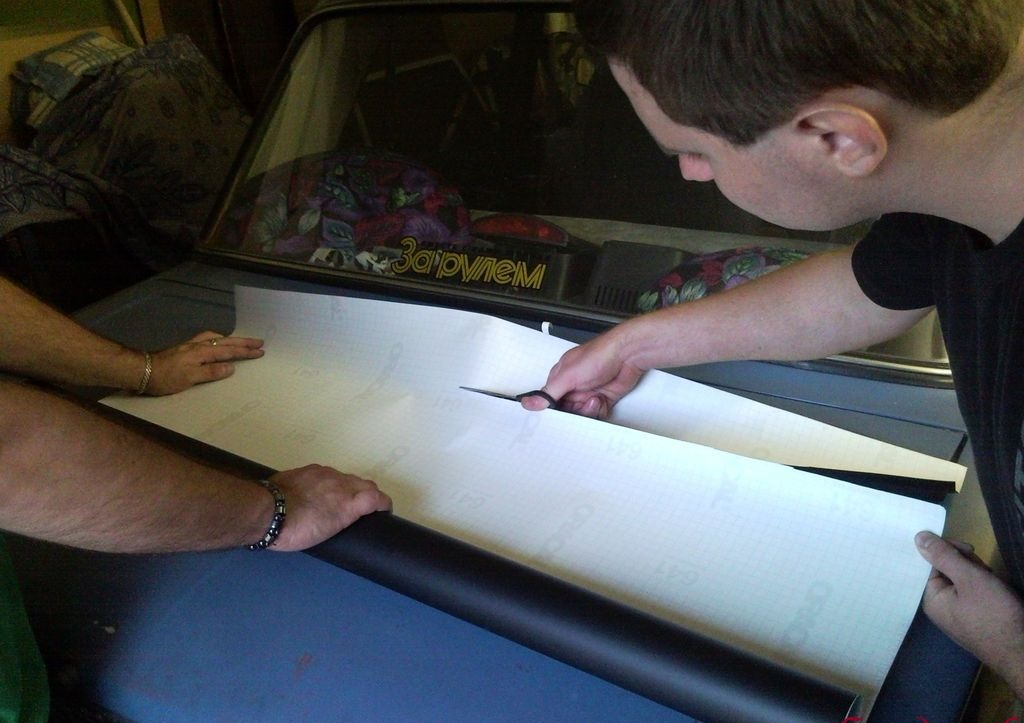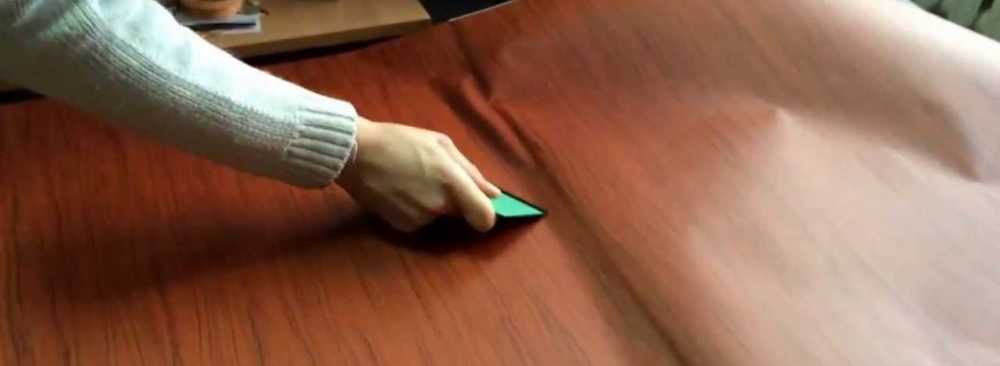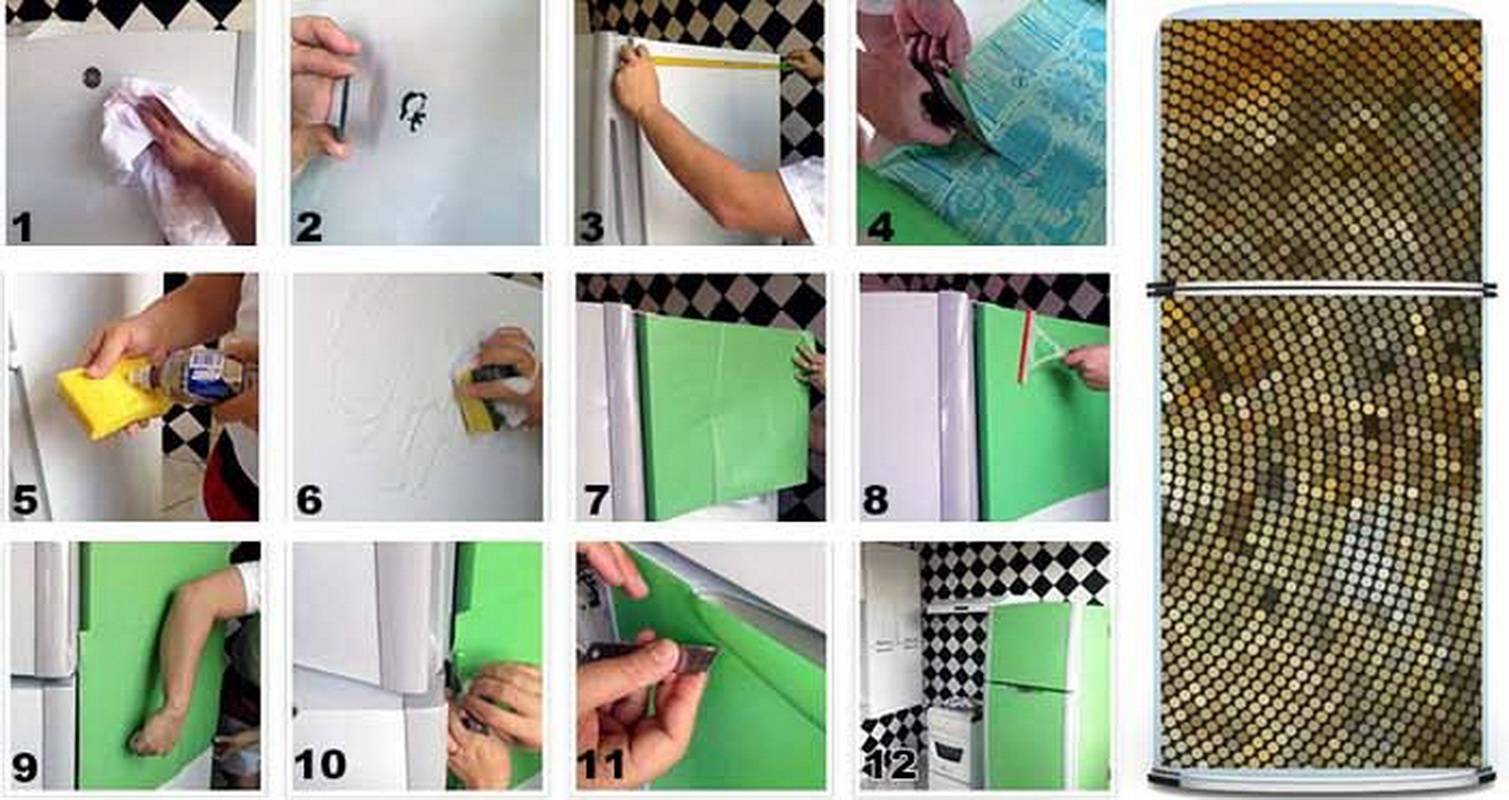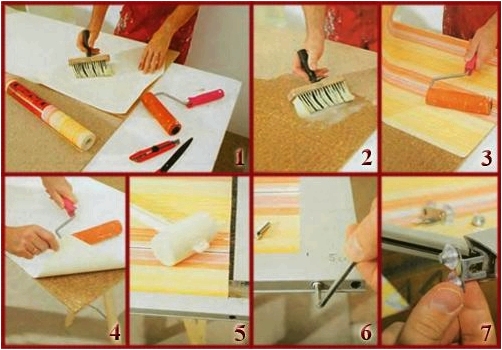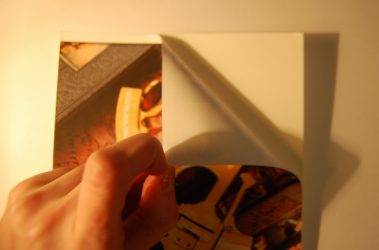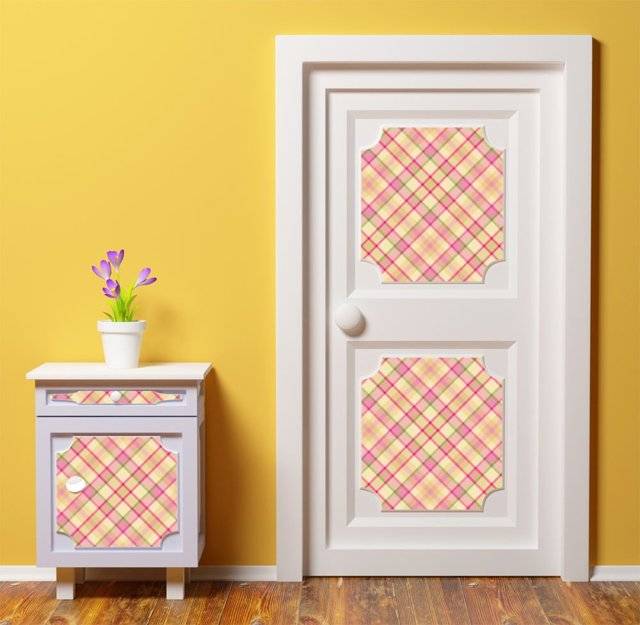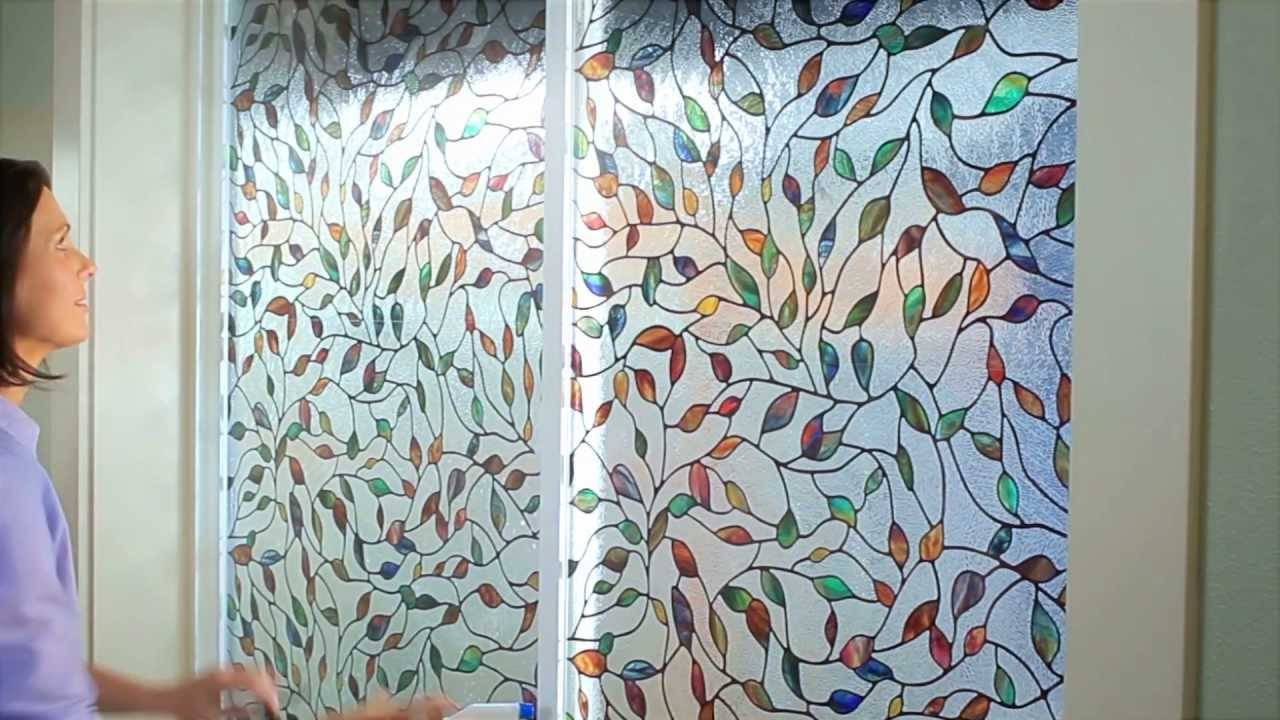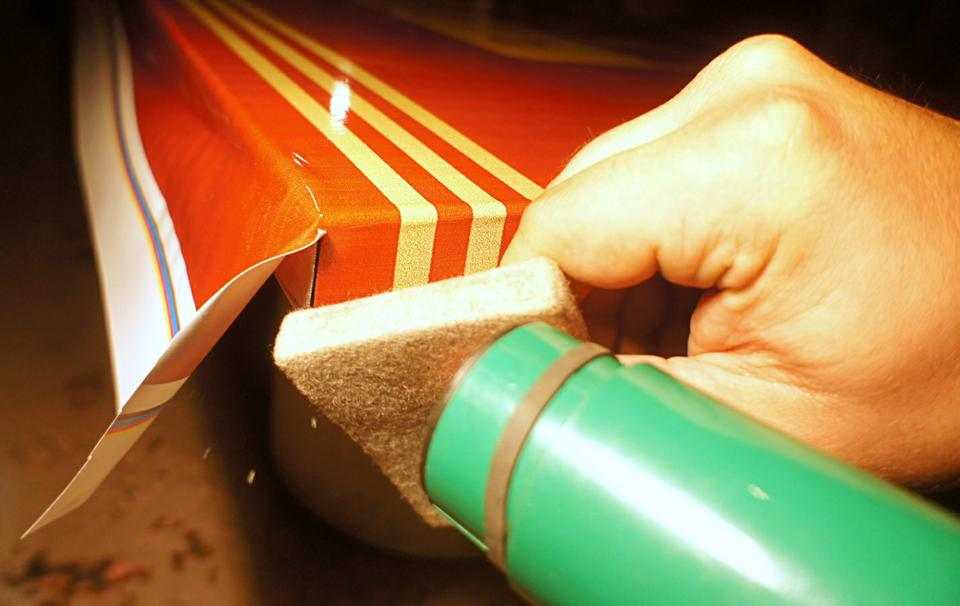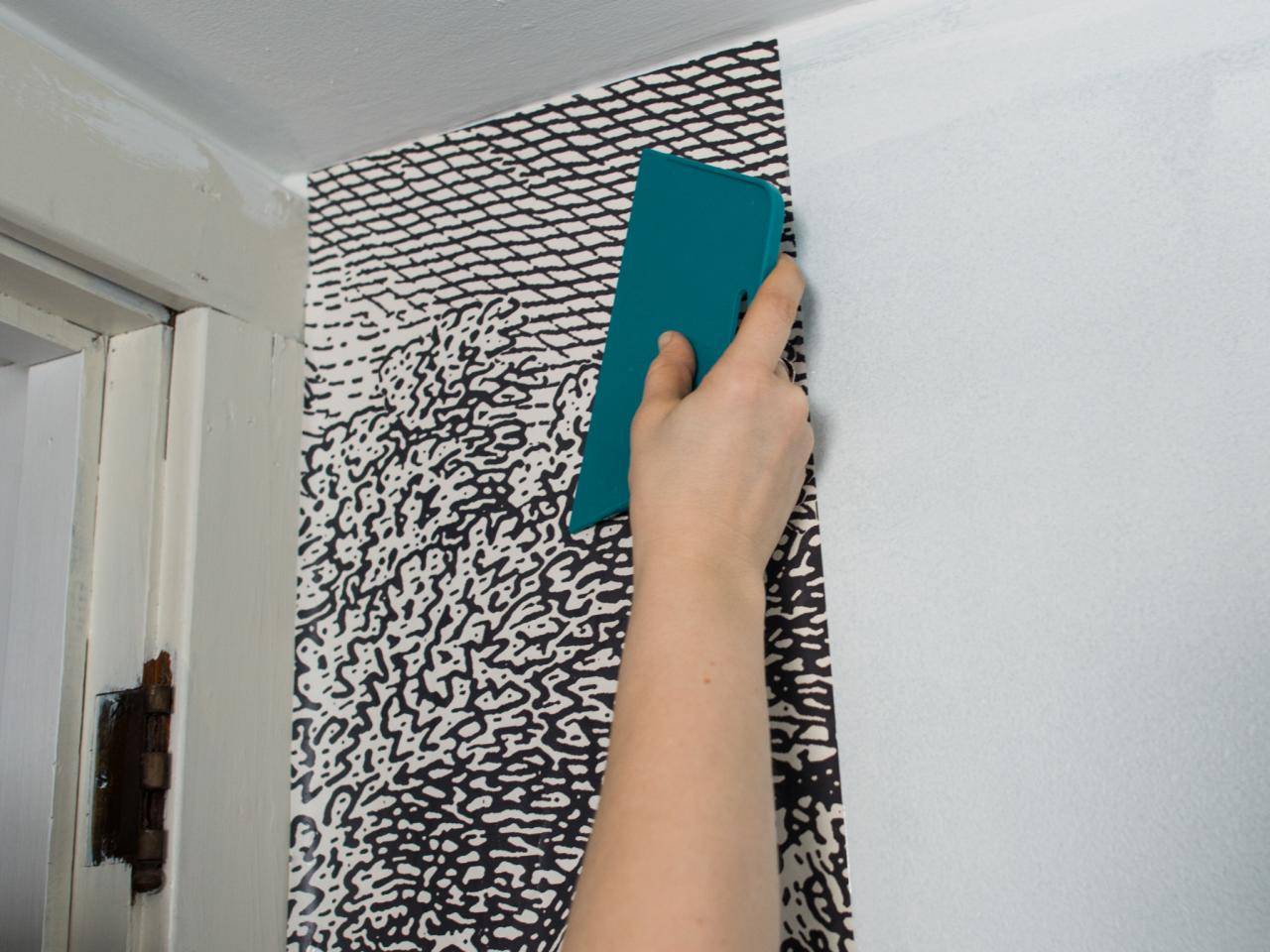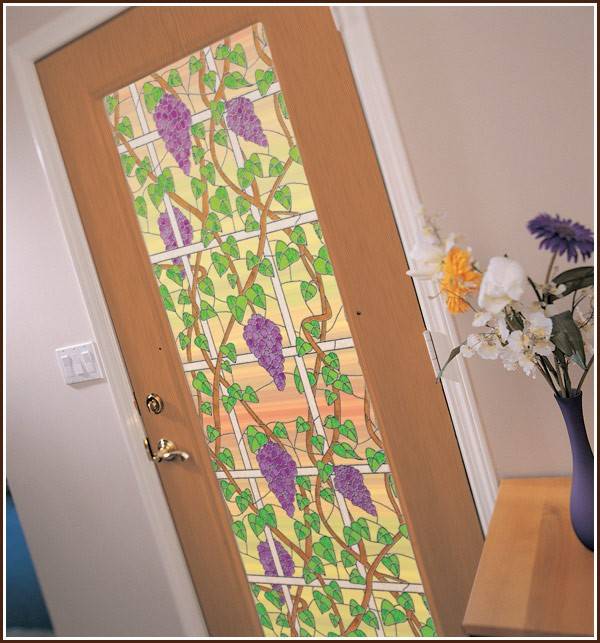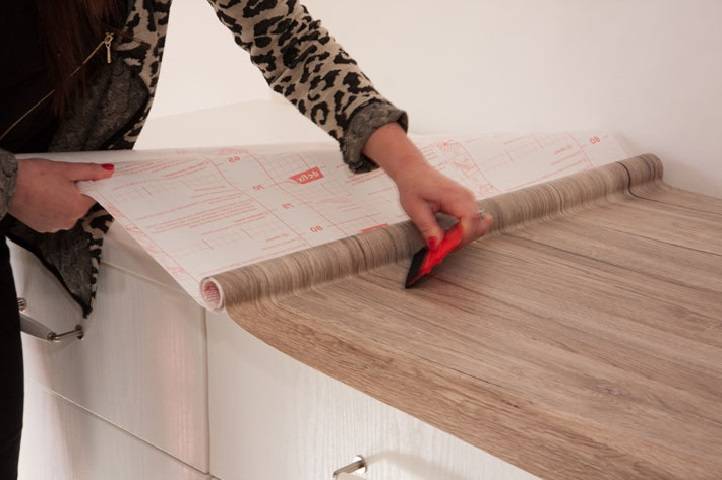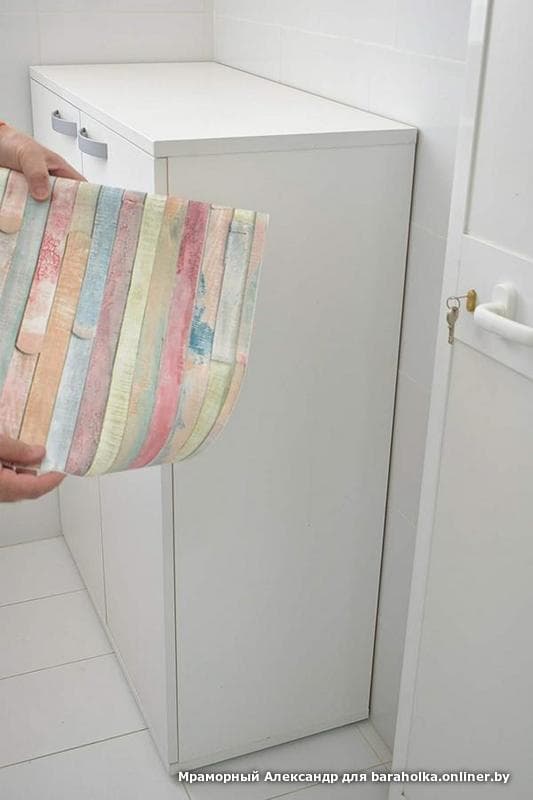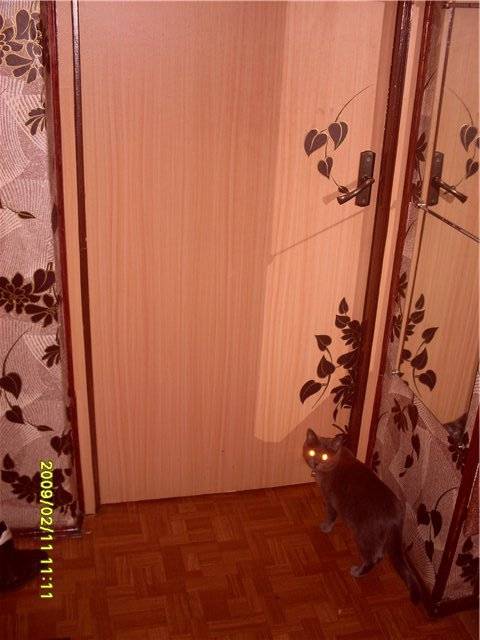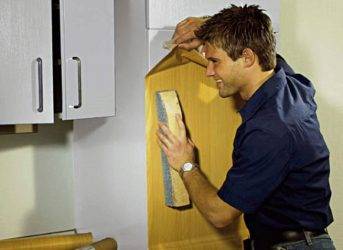Types of films
The material is produced in rolls from two to fifteen meters long. Their width is 45 cm, 67.5 and 90 cm. In a wide assortment there are products with a matte or glossy surface. Among the monochromatic films, metallized films are distinguished. Mirror coating is successfully used for information protection of some objects. How to stick this type of self-adhesive film on the door so that it performs its functions properly is indicated in the instructions.
Decorative films differ in texture and patterns. The most widespread are materials for various types of wood, natural and artificial stone, imitating metal surfaces and even under mosaics.
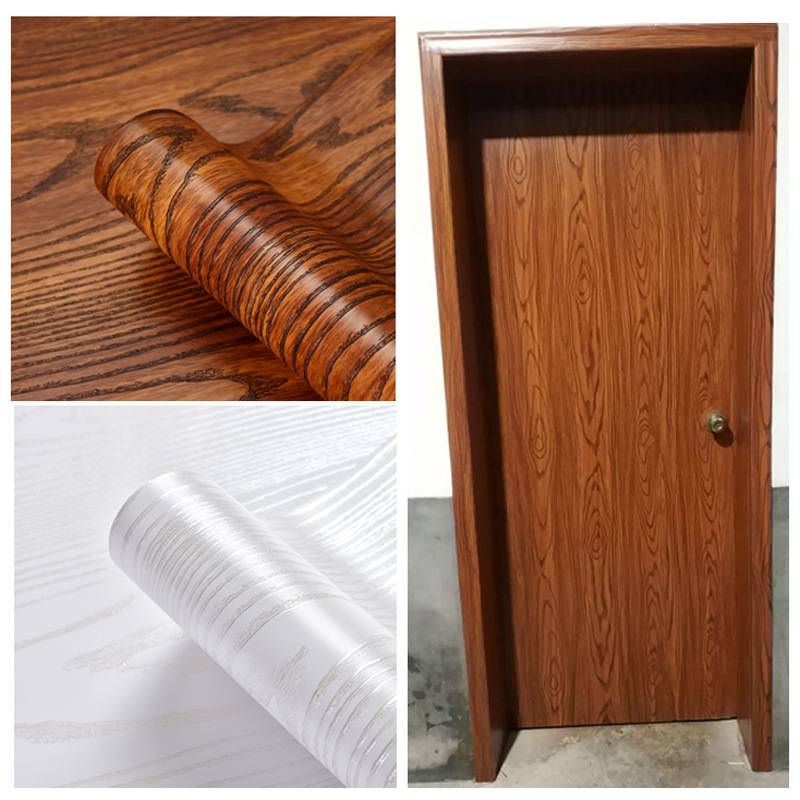
Transparent fluorescent specimens look very original. They are glued to glass doors and glow in low light. Also, three-dimensional products look great on interior canvases.
The adhesive composition on the material can be of two types. As a rule, it is a water-based dispersion acrylate. But its analogue is also found on the basis of rubber. How to properly glue the self-adhesive film and which adhesive is best suited for each individual case will depend on which doors you need to place the material on.
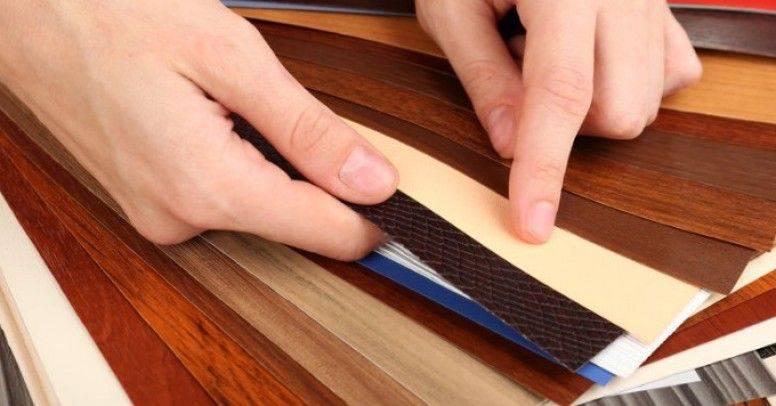
In order for the repair to be successful, it is necessary to initially determine the material, as well as the room where the self-adhesive film on the door will be glued. It would be nice to read reviews about a standard product (any imitation) and its special designs. For example, how the material on which you can write with markers will behave in the kitchen or in the bathroom.
Experts advise to split the purchase into two stages. On the first trip to the store, you need to familiarize yourself with the assortment and choose the one you like. But don't buy. Upon returning home, take measurements and determine the required amount. And only then pick up the purchase from the store.
How to cover the door with self-adhesive film
After completing the preparatory measures, you can proceed directly to pasting the door, performing the actions in the following sequence:
- First, you need to do the markup. The dimensions of the door need to be found out with a tape measure and transferred from the inside of the self-adhesive film. Basically, this process is not difficult, since many manufacturers apply millimeter markings to high-quality material.
- Further, using scissors or a sharp knife, it is necessary to perform extremely accurate cutting of the film, so that as a result the workpiece has perfectly straight edges.
- Next, you can proceed to glue it by applying the upper edge of the cut material to the corresponding place on the door. Separate the protective paper 10 cm from the edge and firmly press the sticky side of the self-adhesive film to the door leaf, making the institution on the end from above.
Note! It is necessary to peel off the paper gradually, immediately sticking the material to the door from top to bottom, smoothing the coating with a rubber spatula or clean soft rags to remove any air bubbles.
Next, it is required to roll up the film at the remaining ends, cutting the corners to reduce the overlap layers.
Upon completion, you must carefully trim the excess on the sides and cut holes for the fittings, and then install the door handle and lock or several in the appropriate places.
In addition, if the canvas was removed before work, then it must be hung back on the hinges.
Having figured out how to glue the door with self-adhesive film, you can purchase the material if this has not been done before, and having prepared the necessary tools, you can proceed to the process with your own hand, observing the recommendations given.
Video:
You may be interested in:
How to choose a seal for an entrance metal door: the nuances of choosing a quality material
How to insulate a metal entrance door from the inside with foam and other materials
How to adjust the door closer correctly yourself
Material characteristics
The film for furniture helps to externally refresh the furniture boards that are already boring over time in a short time. With the help of simple manipulations, the procedure can actually be carried out with your own hands in a few hours. To do this, you only need the material itself and sharp scissors or a construction knife.
Today, the assortment of these raw materials occupies a leading position among other methods of furniture restoration. With the help of the material, you can bring any design solutions to life, while not spending a lot of money.
The popularity of the use of self-adhesive is due to its such advantages:
- the material is supplied in rolls, so that rectangles and squares of the required dimensions can be easily cut;
- the film helps to protect furniture from future scratches, chips, and if they do appear, it will not be difficult to replace the material;
- self-adhesive film will help save the family budget: you do not have to purchase a new headset if there is an opportunity to update old products;
- no additional tools are required for work;
- well suited for kitchen furniture, protecting it from grease, dirt and other damage;
- the material is easy to clean, self-adhesive compounds can be treated with detergents, gels.

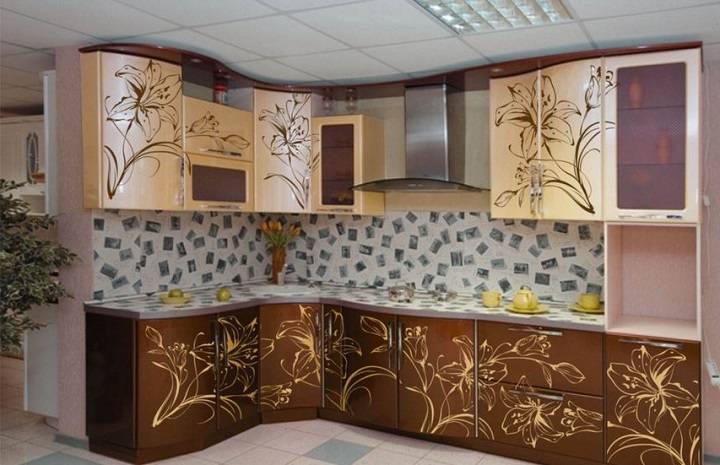
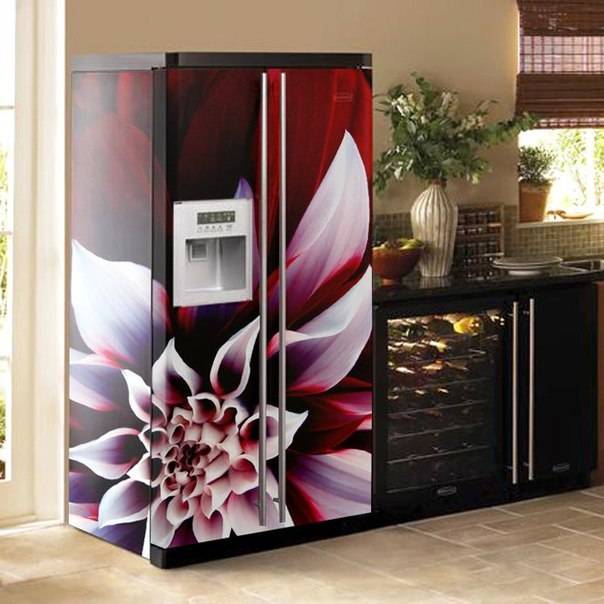

The raw material consists of several layers: face, adhesive, protective. Each of them performs its own function. The very first layer - the front one is made from different material options:
- polymer film - represented by a self-adhesive type of vinyl, which perfectly covers surfaces. She looks very beautiful on furniture, and her decorative abilities are invaluable. In addition to vinyl, PVC or polyester is used;
- foil - used for cladding less-used pieces of furniture, most suitable for wall cabinets;
- paper - paper-based material can be glued to the ends of the shelves, since such a film does not strongly withstand constant mechanical stress.
Decorative films can imitate a wide variety of surfaces: leather, wood, natural stone, ceramics, tiles and fabrics. As a result, it has a wide range of applications, not only in the renovation of facades, but also in the usual decor.
Depending on the material of manufacture, the self-adhesive film is divided into:
- single-layer roll products - produced on the basis of polymers, additives in the form of plasticizers, which give the raw material strength: all components are mixed together and by extrusion they form flat rolls;
- two-layer models - in this case, two canvases are used in the manufacture: a base and a surface, such a material is worse in technical characteristics than a single-layer analogue.
Anyone can glue the furniture on their own; this does not require special skills. Before starting work, select the surface structure of the film, it can be glossy, matte, transparent, mirror and holographic
Each type is used in individual cases, so it is important to determine in advance on the purpose of raw materials
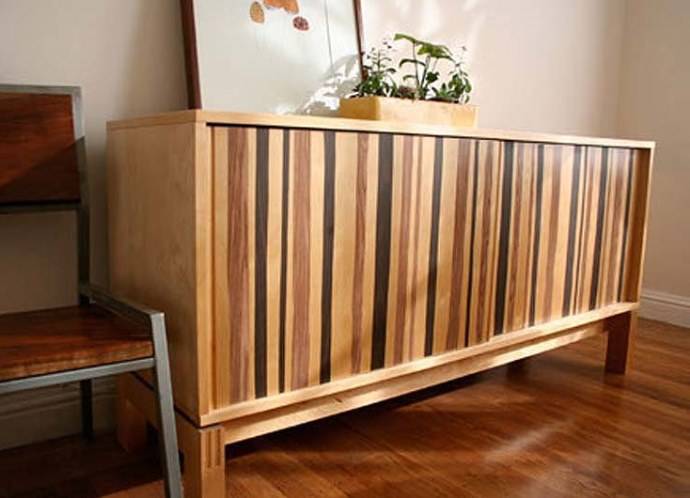
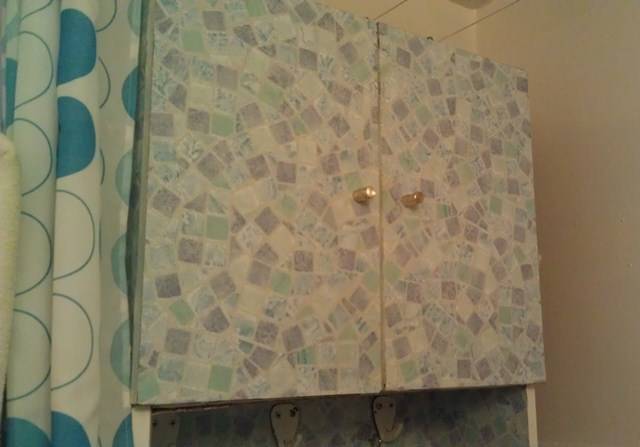

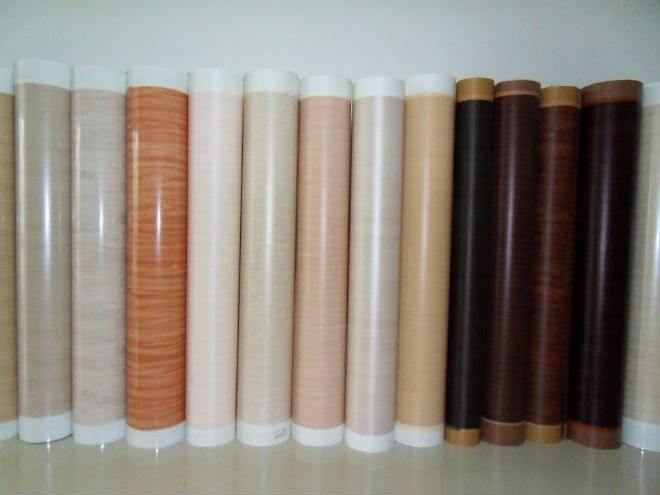

Surface preparation and film bonding
One of the advantages of using self-adhesive film is the minimum set of tools that will be required to carry out surface preparation and material gluing:
- For surface treatment - a grinder, a drill with a special attachment or emery (depending on the degree of roughness and the amount of damage), putty, primer or wallpaper glue for treating a wooden surface, acetone or another solvent.
- For marking, cutting and gluing - a stationery or construction knife, scissors, tape measure, ruler, pencil, rubber roller or spatula and household hair dryer.
Self-adhesive tape can only be glued onto a well-prepared, degreased surface. To do this, follow these steps:
- The door is removed from the hinges, fittings and decorative elements, as well as glass, are dismantled.
- Remove the old coating before processing. For these purposes, a grinder, drill with a nozzle or emery is used.
- The cleaned smooth surface is degreased with detergents or acetone.
- Cracks, chips, deep scratches and impact marks are removed with a putty.
- A layer of primer or wallpaper glue is applied to the surface of wood, plywood or chipboard.
- If the door is very tight against the box, using a planer, remove 0.5-1 mm from the ends (the film thickness is not large, about 0.3-0.4 mm, but it can prevent the door from closing and lead to abrasion of the material).
After removing all roughness and dust residues, you can begin to glue the decor on the door. Usually, manufacturers place instructions for working with their product inside the package or on the back of the self-adhesive, but the general sequence of actions looks like this:
- Using a tape measure, the size of the door leaf is determined.
- The film for the door is cut according to the dimensions obtained with a margin of 2-3 cm.
- Next, you should glue the end part of the door, while making an overlap on the canvas of 1-2 cm.
- A few centimeters of the protective layer are separated and the edge of the film is glued with an overlap on the upper end of the door (due to this, the seam will not be visible). The protective layer is gradually removed, the film is simultaneously pressed against the door leaf and smoothed with a rubber roller or spatula in the direction from the center to the edges. In case of wrinkling, the film is peeled off, straightened and re-glued. If small air bubbles appear, you can do without re-sticking - just pierce them with a needle and smooth them out, the puncture mark will not be visible.
- If several strips of material are used for pasting, the joint is overlapped by 3-4 mm.
- Bending points are glued with a hair dryer. The heated film is heated at the bend and glued in a taut state, after which it is pressed tightly to the surface until it cools.
- Firm adhesion in places where the film is folded to the end is achieved by ironing it through a sheet of thick paper or fabric.
- The quality of pasting should be assessed at a distance - if irregularities or distortions are found, the sheets can be re-glued (the average time for the glue to completely cure is 5-6 hours).
- After making sure that there are no flaws, all the remnants of the film are cut off with a sharp construction knife.
- Fittings are installed, the door is returned to its place and its free movement is checked.
How to easily cover furniture and walls with self-adhesive film
When some time passes after the repair and purchase of furniture, there is a desire to somehow refresh the interior, give it a new life. However, not every time we have the opportunity to afford radical changes. It is under such circumstances that a simple and affordable method of renovating walls and furniture helps us. It is also useful if you need to hide small cracks or traces of children's monumental painting.Let's take a closer look at how to use self-adhesive tape so that the result of our labors will bring joy.
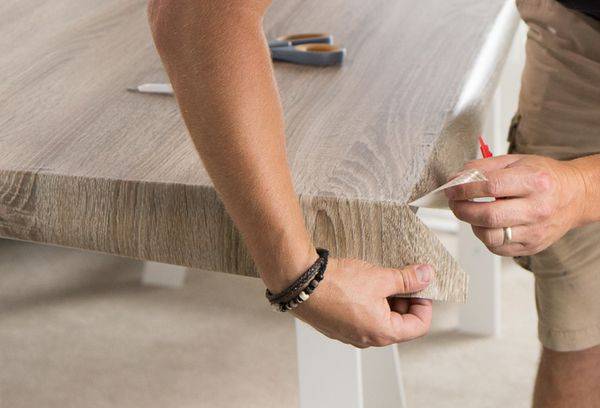
This type of coating, which came to our market for a long time, is now gaining its popularity. Due to its low cost, rich palette and variety of patterns, and mainly - ease of use, self-adhesive is widely used in decoration.
As with any material, film has its own characteristics, so a certain approach is required.
Step-by-step instructions for pasting
Accurate gluing of the self-adhesive film to the door involves several steps:
- Carrying out the markup for the original material. Measure the door with a tape measure, mark the canvas with a pencil. If the width makes it possible, then the marking should be made taking into account the bend to the end side. For application, the reverse side of the material with millimeter markings is used.
- Cut out the pattern with sharp scissors or a knife. You need to cut it very evenly, otherwise the result of the work will be poor.
- We glue the door. Pasting begins from the top, after peeling off the protective layer by 10 centimeters. If the canvas was cut taking into account the end, then we put the material on the end, then pressing down gradually to lower, smoothing the used material into the edges. For better, quicker smoothing, a rubber spatula is used.
- Excess material is trimmed.
- A place for the handles is cut out.
- If a bubble has formed and it is not possible to remove it with a spatula, then carefully pierce it with a needle and press it down with a dry cloth.
Also, before starting work, we advise you to watch the video instruction:
The choice of film, taking into account the type of room
In order for the pasting of furniture with self-adhesive film to be successful, and in the future to serve for many years, you need not only to purchase high-quality material, but also take into account the type of room in which the surface will be used. Raw materials for the kitchen and bedroom have their own characteristics, so when choosing, use the following tips:
film for furniture intended for a bedroom or living room should not only have an attractive appearance, but also fit into the interior. If earlier the facades of cabinets and tables had a certain color, it is not at all necessary to repeat it - you can purchase rolled products of a different shade, but do not forget about compatibility with upholstered furniture and finishes. In well-lit rooms, a matte film is ideal - its structure will be perfectly visible in sunlight
When choosing a self-adhesive base for a bedroom, pay attention to products that imitate natural materials. Such options will be appropriate for decorating the facades of wardrobes and dressers;
to keep the kitchen set looking like new, it can also be covered with vinyl material
For this room, the characteristics of the strength of the raw materials and the ability to constantly withstand mechanical stress are very important. Gloss will look good here, but remember that the surface requires careful maintenance. Many designers recommend using self-adhesive formulations with photo prints and vibrant images. The drawing of citrus fruits will be in place for the kitchen;
you can also update furniture in a bathroom or toilet using this raw material. Due to the properties of not absorbing moisture, the pasted surface will not only look beautiful, but also have practicality. For the facades of cabinets and cabinets in the bathroom, use options that are consonant with the colors of the facing tiles of the floor and walls;
to freshen up the nursery, glue the material with the image of your favorite cartoon characters. Children are always happy with new things, and such a surprise will delight them. The assortment of films with fairy-tale characters will help the kid to make the right choice. The raw materials are used for wardrobes, bedside tables and even tables for doing homework.If the plans do not include a complete replacement of the appearance of the furniture, you can stop at the use of separate drawings for decoration.
To renovate the outside of glass cabinets and showcases, treat furniture with transparent self-adhesive film. Such material often has a small applied pattern that will help diversify glass facades.
When choosing a material, think carefully about the future design. Certain types of holographic or glossy film can have the opposite effect and create a cluttered feel in the room.

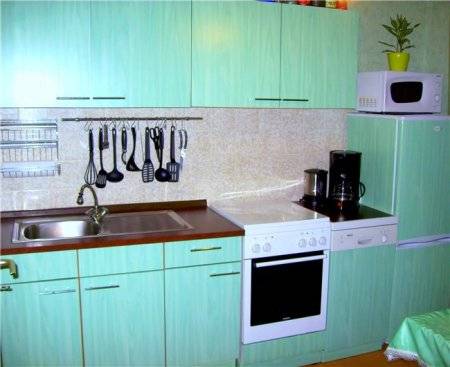

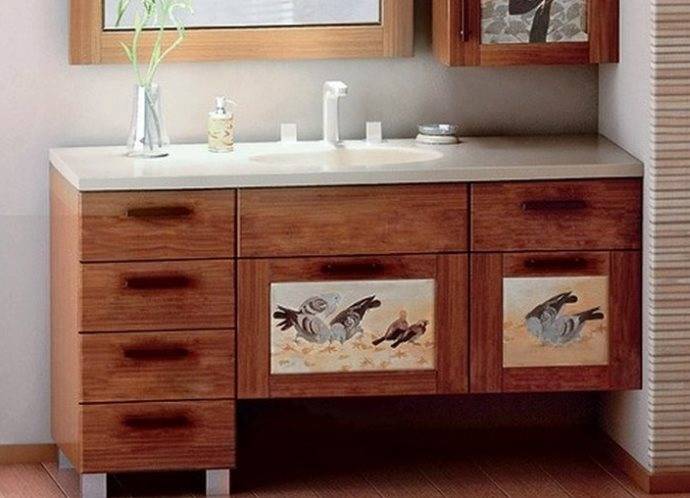
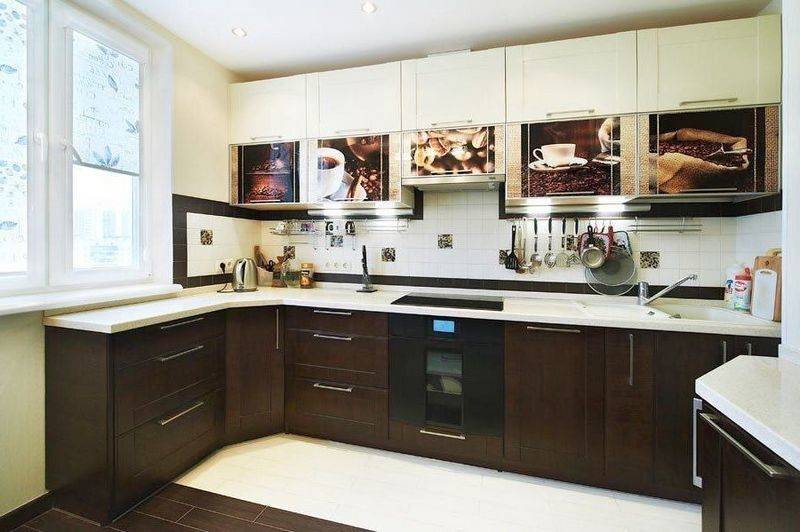
Preparation for gluing
In order for the self-adhesive film to lie flat, you need to know the rules for handling it. First of all, remember that it is thin and any protrusions, depressions, irregularities will be visible, especially on a glossy monochromatic film. Therefore, before gluing, the surface is leveled to an ideal state. When it comes to old furniture, you can use wood putty. You can dilute the usual finishing putty with PVA, diluted with water (1: 1). With this composition, close up all the irregularities. Only knead in very small portions - literally a couple of tablespoons of the powder. Try to immediately make the surface perfectly flat - after drying, it is very difficult to sand.
So you can change an old refrigerator using self-adhesive
The leveled surface is cleaned of dust, dirt (with water and dishwashing detergent), and dried. Everything must be removed carefully: even a drop of fat when it comes to changing the "image" of the kitchen set. If you use abrasive or acidic products, everything will need to be thoroughly removed, washed several times with water and liquid dishwashing detergent.
If the surface is loose (there are areas of putty, for example), it is better to cover it with a primer. The primer is selected according to the type of surface, taking into account the adhesive composition on the PVC film. A universal option is PVA glue. It can be slightly diluted with water and greased on the surface. Just make sure that there are no streaks and smudges - all this will be emphasized with the film. The second type of primer is acrylic. Why exactly she? Because the adhesive on the self-adhesive vinyl has just such a base.
If the original substrate is very loose, two coats of primer may be required. After drying, check for leaks. If everything is smooth, you can start finishing.
Advantages and disadvantages of self-adhesive film
The material is in significant demand on the market due to a number of the following positive qualities:
- Ease of use. Even a person who is engaged in such work for the first time is capable of pasting the door leaf with foil without any particular difficulties.
- Huge and varied assortment. There are many films on the market in color and texture, so you can choose the most suitable option in accordance with personal preferences and the interior of the room.
- Resistant to sunlight. A material made from high-quality raw materials does not have such a disadvantage, unlike cheap products, in which this occurs quite often.
- Ease of maintenance. The self-adhesive film can be easily cleaned of dust, grease and other contaminants, for which in most cases it is only necessary to wipe it with a cloth moistened with water or ordinary detergent composition.
- The ability to use for pasting products made of different materials.
- High wear resistance and toughness. A high-quality self-adhesive film can withstand light shocks and minor mechanical impacts well, ensuring the door is protected from scratches.
- High resistance to moisture. The material does not allow water and steam to pass through, which means that it can also be freely used in the bathroom or in the kitchen.
- The film does not do any harm not only to metal, but also to wooden door structures.
- It is able to hide small defects present on the surface of the glued product. Through it, you can hide the flaws in the door that have arisen during its long period of operation.
- Affordable price. In comparison with other materials intended for cladding door structures, the cost of a self-adhesive film is noticeably lower.
Taking into account all the above advantages, self-adhesive film has a long service life and is an excellent option for finishing doors.
In addition to a number of positive qualities, the material has several inherent disadvantages:
- With poorly performed gluing, after some time, it can begin to lag behind the surface.
- The material is intended for single use only.
- Before gluing the door with a self-adhesive film, its surface must be prepared in advance. Particularly careful work must be done when finishing structures with polymer coatings.
In addition, it is not able to mask large defects, in the presence of which it is better to give preference to other more suitable options.
Film instructions
Let's consider in detail how to glue the self-adhesive film on the door. First of all, you need to prepare the tool. You will need a ruler, tape measure, and a pencil for marking. A rubber spatula will be useful. For surface preparation, sandpaper is indispensable. You will also need a primer and mastic. For correction, you will need a spray bottle with water and a hair dryer.

The algorithm of actions is as follows:
- The surface of the door leaf is cleaned from irregularities. Paint drips are removed and burrs are cut off, as well as roughness;
- Then the entire plane is primed. This will allow the adhesive to adhere better to the surface;
- After marking the polymer material, all excess is cut off. For convenience, its back is lined with squares;
- Pasting starts from the top of the canvas, moving down;
- Bending back the backing, glue the corner of the canvas. Then the material is spread to the sides and down.

There is one trick for inexperienced and insecure DIYers. Before gluing the door, you need to spray the canvas with a spray bottle with soapy water. This will allow the self-adhesive tape to be operated. It will slide on the surface and can be moved to the sides. After fixing in the right place with a soft cloth or spatula, water is expelled from the rubber. Then the surface is dried with a hairdryer. But it should be warned that overuse of water can spoil some material. For example, if the base is paper. To make it clearer how to stick the self-adhesive film on the door in this way, it is better to watch the video.
The DIYer also needs to know how to remove the already pasted film. This will come in handy when you want to change the interior of the room and need to change the texture on the door. There are several techniques to cope with this difficult task.
You can use a hair dryer first. It is necessary to warm up the corner of the film, pry it off with a knife and gently pull it towards you and down. If the material lags normally from the surface, then you can continue to move. In those places where a hitch occurs, it is necessary to warm up the areas with a hairdryer.

The stores sell "Label and Decal Remover". This is a special highly penetrating aerosol composition that you need to spray under the edge of the film and wait a little while it flows inside. So move, gradually adding aerosol to the surface. The famous spray can WD-40 has a similar effect.

If you want to suffer with solvents, then it is better to choose white spirit or 646. You cannot use their fatty varieties. You need skill to work. You need to try to soften the glue by applying a moistened swab to the surface and then wipe off the excess with a dry cloth.But in any case, do not rub the solvent on the door. Mixing with glue, it is capable of disrupting the structure of the material.
Benefits of using film
There is a bonding base on one side of the PVC sheet, and a decorative pattern on the other. The gluing takes place without effort and time-consuming, since there is no need to apply additional products with subsequent processing.
Other positive qualities include:
- Durability. The service life of the material depends on the quality of the application and the environmental conditions.
- Strength. The structure resists scratching.
- Resistant to moisture. Steam and moisture do not penetrate through the coating, therefore it is often used for kitchen furniture.
- Wide choose. Manufacturing takes place using foreign equipment. This allows us to produce films of different colors with patterns like wood, stone, brick, with patterns. Monochromatic models, as well as mirrors and with a photo print, are in the lead.
- The binder contains no harmful components. On contact with wood, the glue penetrates into the structure of the material, providing reliable adhesion, but the coating is not damaged.
- Hides defects.
- A simple detergent removes dirt from the self-adhesive without leaving any residue.
- Resistant to sunlight - suitable for front door coverings.
- The price of the product is much lower than that of other similar materials.
There are minor disadvantages behind many of the positives. The film cannot be reused, as it loses its original properties after peeling off. The choice of the incorrect application technology leads to the formation of bubbles, therefore, you should consider in detail how to properly glue the self-adhesive film on the interior doors.
Film is a simple material that allows you to breathe a second life into furniture or door structures in a few minutes. Due to its positive properties, it has found wide application in the household. The quality of the result depends on the pasting technology. An important stage is preparation, which involves the removal of old finishes, elimination of defects, degreasing. It is glued gradually, smoothed from top to bottom, bubbles and irregularities are removed with a rubber spatula.
Material characteristics, advantages and disadvantages
To change the design of old furniture, it is often advised to paste over the surface with PVC film with an adhesive applied to the back side. These films are also called "self-adhesive", since after removing the protective layer, it is simply applied to the base and, due to the applied glue, is glued. A more "cultural" name is a self-adhesive film for furniture. It is under this name that it can be found in stores, on the market.
The assortment of flowers is large
Why is this film popular? Because it has a low price and has a lot of color / color options. The film is waterproof and can be used in wet areas. If you know certain rules, it is not difficult to work with it, it is easy to take care of the glued surface - all dirt remains on the surface and is not absorbed. In general - a good option if you need to update furniture or doors, but there are no funds to buy new ones.
There are also disadvantages and in sufficient quantity:
- Self-adhesive film sticks well only on smooth surfaces.
- Preliminary preparation is required. The film is thin, all defects will be visible, therefore, the surface must first be leveled to an ideal state.
- It is difficult to make the joints perfect - they are usually visible.
- In places of active friction, the film can be rubbed.
- It is difficult to peel it off from some types of surface.
At a low cost, a very good result is obtained.
As you can see, not ideal, but not bad. It is difficult to replace this method of changing the decor - only the gluing of a new veneer, which is much more expensive and technically more difficult.Cabinet furniture is also pasted over with wallpaper, then varnished. This method is cheaper (possibly), but more often it is necessary to change the decor.
2 Advantages of self-adhesive - why is it so popular?
The demand for self-adhesive films is due to their high performance and decorative characteristics. They have the following advantages:
- Ease of use. Any home craftsman can ennoble the door leaf with self-adhesive.
- Large selection of materials. Feel like a professional decorator, making a small piece of art out of your door using films of various textures and colors.
- High wear resistance and sufficient strength. A high-quality self-adhesive coating is able to withstand minor mechanical shocks and protect the door structure from scratches.
- Possibility of facing products from various materials. We have already said that self-adhesive is suitable for all surfaces.
- Resistant to sunlight. Note that cheap films can fade in the sun. But products made from good raw materials are devoid of such a problem.
- Ease of maintenance. Self-adhesive is very easy to clean from grease particles, dust and other contaminants using water and a cloth.
- Unique moisture resistance. PVC products are not afraid of steam and water. For this reason, they are ideal for covering bathroom and kitchen doors.
- Affordable cost. Renovating a door with self-adhesive is significantly cheaper than any other finishing material.
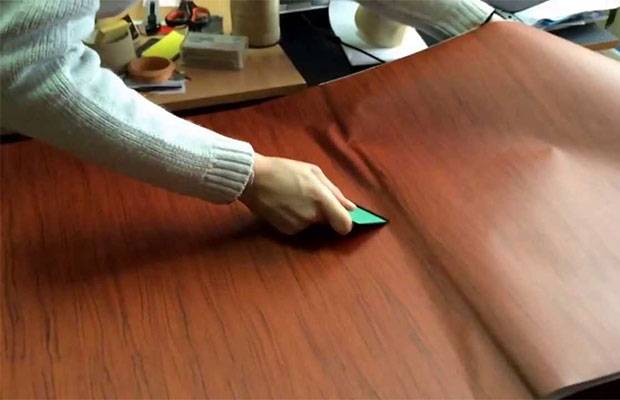
Self-adhesive is very easy to use
In addition, dense films allow you to hide minor flaws (small scratches, dark spots, and so on) of the decorated surface.
Let's talk about the disadvantages of self-adhesive. They are also available. First, the film can only be glued once. Secondly, polymer coatings require a rather laborious and tedious preparation of the surface on which they will be mounted. Thirdly, work with the film should be extremely careful, focusing on the recommendations of manufacturers and specialists. If the gluing is performed poorly, the PVC material will very quickly fall behind the door. And you will have to look again for ways to effectively update it.



